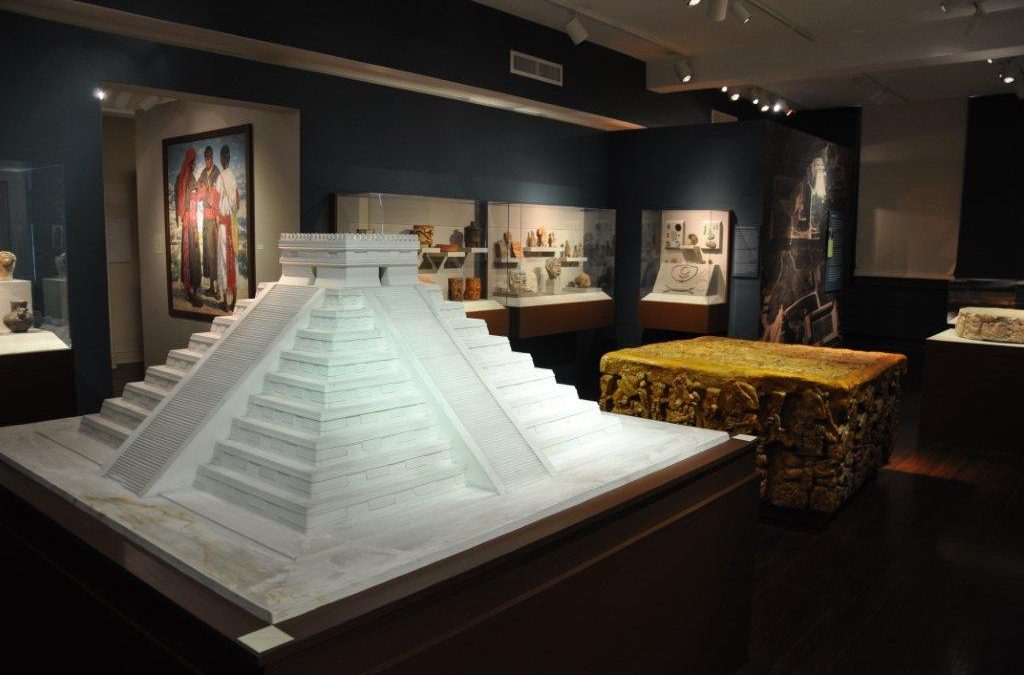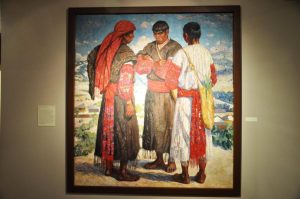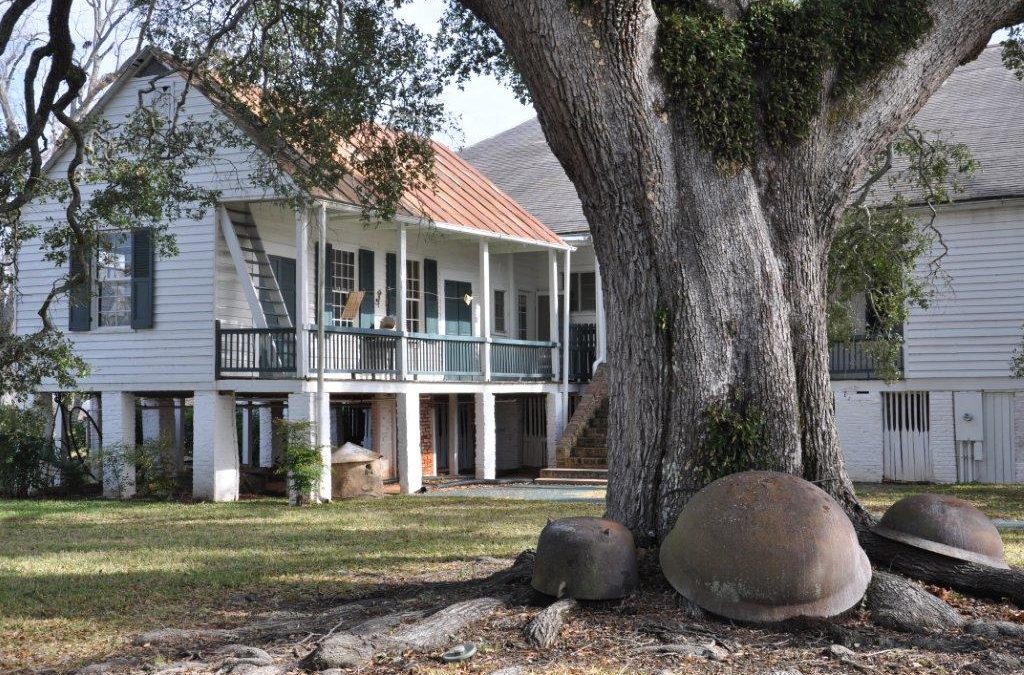
by admin | Jan 29, 2013 | Greater New Orleans
On our evening walks around Uptown New Orleans, we’ve discovered one the best places to take rambunctious kids is Tulane University. We get a little bit of exercise walking there, and they get to jump out as soon as we reach the university and let loose. It’s the perfect place to hunt for cicadas and stick bugs, climb in the rock garden, play in the fountains and chase the stray cats that seem to thrive on campus.
 |
| Carved Stone Head |
As part of our routine, we stop in the Anthropology building for a water and bathroom break and to peak in the main office at the fascinating decorated skeleton occupying the corner chair. During the recent hype over the end of the Maya calendar, a Times-Picayune article came out about a Maya exhibit in this very building we so often frequented. “Faces of the Maya: Profiles in Continuity and Resilience” was hidden two floors above us in Dinwiddie Hall’s Middle American Research Institute.
Normally only open Tuesday through Friday, 10 a.m. to 3 p.m., the museum was fairly inaccessible to us. However, on our latest walk across campus, we decided to ascend the steps to the third floor to maybe catch a glimpse of the exhibit through the window. Luckily, the Institute Director Marcello Canuto must have heard all the ruckus we were making outside his office, and upon discovering what we were up to, gladly opened the museum for us.
It was quite an amazing display depicting the Maya culture, from carved figurines and pottery examples to delicate jewelry and ballgame rubbings. The story of the Maya is intertwined with the artifacts, leading the viewer through the civilization’s earliest existence to today’s descendants who still live throughout southern Mexico, Guatemala, Belize and Honduras.
 |
| Plaster Cast from Palenque God House |
The kids were drawn to a plaster model of El Castillo, a scaled-down version of a Maya temple-pyramid with a series of steps perfectly sized for the butterfly that we had picked up on today’s outing. An accompanying description explained that when the sun hits the platform during the equinox, snakes appear to slither down the pyramid–a sight I can only imagine to be awe-inspiring.
Nearby, I was drawn to a plaster cast of an altar so intricately detailed I could have spent hours staring at it. Alas, as I looked up, the kids were already out the door and headed down the stairs. I briefly stopped one last time to admire a vibrant painting of three Maya men seemingly deep in discussion before darting out the door and shouting a quick “thanks” to Director Canuto.
 |
| Painting of the Maya |

by admin | Jan 15, 2013 | Featured Posts, North Louisiana
From downtown Natchitoches, we took the winding Highway 494 out the east side of town into the rural countryside. Approximately 116,000 acres surrounding Natchitoches make up the Cane River National Heritage Area, which includes several state historic sites, national historic landmarks and the Cane River Creole National Historical Park. The latter is where we were headed, in search of learning more about the Creoles who once thrived in this area.
We had an ambitious day planned, stopping by both plantations included in the National Historical Park, Melrose Plantation in between and then Kisatchie National Forest on the back end of the trip. The route led us first to Oakland Plantation, where we rushed from the parking lot to the nearby pavilion, trying our best to escape the frigid morning air. We picked up a self-guided walking tour and followed the well-defined path toward the tractor shed and mule barn. Not only is the National Park property free to visit, but the scattered out buildings are all open wide for easy touring. We poked our heads inside one building after another, admiring the construction and discussing the old tools and remnants of the past.
 |
| Oakland Plantation Store |
The path steered us toward the old store and post office, which today serves as the Visitor’s Center. Inside, the drafty store held many of the same items available for purchase from when the site was a working plantation. As we poked around, a ranger appeared offering a tour of the main house. Luckily, we were the only ones present at the time, so she adjusted the tour to accommodate the attention spans of a four and two year old. After swearing the kids in as honorary rangers, she showed us the rare and highly guarded bottle garden, where old glass bottles lined the plant beds. We then entered the house, viewing an interesting mix of antique furnishings and modern conveniences such as a TV and “new” kitchen. The ranger told us about the owners, African Americans and Cane River Creoles who once lived and worked here before their property became a testament to the past.
.JPG) |
| Oakland’s Bottle Garden |
 |
| Honorary Ranger Charles |
From Oakland, the road followed the river to Melrose Plantation, significant for the artist colony it once held and the cook turned self-taught artist known as Clementine Hunter. We paid to tour the grounds, and started on the far side of the main house by an abandoned cellar. The kids were overjoyed to find the remains of an armadillo inside, and four-year-old Charles busied himself snapping hundreds of photos with my husband’s iphone. Caught up in his excitement, he dropped the phone inside the doorless building, and Paul was forced to jump through an open window into the pit below to retrieve his phone.
.JPG) |
| Melrose Plantation |
.JPG) |
| Africa House at Melrose Plantation |
Adventure now over, we were able to hustle the kids around to the property’s other historic buildings, such as the Yucca House built between 1796 and 1814 and the highly unusual Africa House and its upstairs Clementine Hunter murals. Hunter’s own small cottage was nearby, another favorite of the children for the lizard that had taken refuge from the cold on her porch.
By now needing lunch, we didn’t stay long at Melrose but were glad we stopped to view this important piece of Louisiana history. The Cane River trail stays true to its past, depicting rural life in the Natchitoches area. Unfortunately for us, this also meant no restaurants in sight. So we scrounged around for the last of our snacks and carried on to Magnolia Plantation, the second of the two National Park properties.
.JPG) |
| Slave Cabin at Magnolia Plantation |
The main house at Magnolia is still privately owned, but the store, a collection of slave houses and a gin barn are all open to the public. Stopping to briefly chat with the ranger inside the Visitor’s Center, he encouraged us to walk the lands and take a look inside the gin at the only wooden screw-type cotton press remaining in its original site. A stack of paper bags lay next to a sign encouraging visitors to gather pecans, so we gave each of the kids their assignment and let them loose. While they competed to see who could find more pecans, we walked around the eight brick slave cabins and viewed the exhibit inside the farthest one. A modified Catholic miraculous medal and several bottles were displayed, evidence of hoodoo rituals and a reminder to me of the Travel Channel’s “Ghost Adventures” show shot here.
.JPG) |
| Kisatchie National Forest |
The ranger had directed us toward a gas station selling sandwiches, where we stopped to refuel both ourselves and the car before crossing I-49 to the Kisatchie Ranger District of Kisatchie National Forest. Home to the 17-mile Longleaf Scenic Byway, the Kisatchie District is touted as one of the most beautiful locations in the state, featuring a landscape of buttes and mesas rarely seen in Louisiana. Shortly into the drive, we stopped at the Longleaf Vista Recreation Area to stretch our legs on the mile and a half interpretive trail.
We were rewarded with a tranquil stream and expansive views of the surrounding wilderness on a surprisingly strenuous hike. Perhaps the difficulty came from carrying kids up and down countless stairs to the flat tops of buttes, but the scenery was well worth the effort. We had even heard rumors that fossils could be found in these hills, but luck was not on our side this time around and we returned only with the pictures and memories from the day’s events.
.JPG) |
| Hiking a Butte at Kisatchie |
.JPG) |
| Sunset at Kisatchie National Forest |

by admin | Jan 8, 2013 | North Louisiana
I’ve wanted to visit the city of Natchitoches ever since first hearing about it in college. The town’s name alone implies someplace special and unique. Dubbed the “City of Lights” in honor of its Christmas light show during the holidays, Natchitoches has been featured in all the regional magazines as one of the must-see Southern towns.
.JPG) |
| View of the Red River from Grand Ecore Visitor’s Center |
I don’t know what took us so long to get there, but we finally booked our hotel and began the four-hour drive northwest over the New Year’s weekend. Despite leaving early, we arrived late Saturday afternoon and took a quick drive-by peak at downtown before heading north to the Grand Ecore Visitor’s Center. Perched on an 80-foot bluff along the Red River, the Visitor Center offers spectacular views as well as a short trail along the bluff’s edge. Inside, various exhibits outline the history of the area, from paleontology and Native Americans to the Civil War and the importance of the Red River. We had made it just before closing time, and the kids had a brief window to try their hands at a simulator where they navigated a ship through a lock in the river.
.jpg) |
| Front Street |
The gate closed behind us as we left the site to drive back into Natchitoches’ historic district. The evening sky was darkening already, and the city’s lights were blinking on over the street and across the banks of the Cane River Lake. Front Street, with its ornate buildings decorated with elaborate cast iron railings, was packed with people mingling about waiting for the last fireworks show of the holiday season. We mingled among them, window shopping through the Christmas-themed display of the 1863 Kaffie Frederick Hardware Store and peaking down alleys and into intimate restaurants.
Chilled from the winter air, we popped inside the Cane Brake Cafe for a late café au lait, “real” chocolate milk and the finest cupcakes I have ever seen, with a giant magnolia icing flower placed delicately on top. After the boys were re-sugarized, we let them loose along the river, where they danced under the fake snow blowing overhead and chatted with horses waiting for their next buggy tour. We made it the full length of the light show before racing back to the car, blowing warm air on our frost-bitten fingers.
.JPG) |
| Lasyone’s Meat Pie |
Cruising Second Street to take in more sightseeing, we spotted the famous Lasyone’s Meat Pie Restaurant. Rarely open past three o’clock, the restaurant had made an exception for the festival, and we landed one of the last tables for the night. To say their meat pies were good is a severe understatement. I’ve tried so-called “authentic Natchitoches meat pies” at several festivals in New Orleans, and they pale in comparison to the real thing. These amazing puffs of beef and pork melt in your mouth and are excellent paired with red beans and rice. My only regret is we didn’t buy a dozen frozen ones to bring home with us. The fireworks began as we exited the restaurant, and with my youngest crying in terror, we packed them into the car and found a church parking lot with a front-row view.
Day two in Natchitoches started at the National Fish Hatchery. Although the main hatchery is closed on Sundays, we tested the front door and discovered the aquarium is apparently open all the time. It was a large room lined with oversized fish tanks and a child-sized viewing platform underneath. My four-year-old snapped dozens of pictures, capturing every fish in the place, while August ran from tank to tank pointing and screaming “fish, fish!” I busied myself with the miniature Caddo Indian village depicting how life would have been for the Native Americans who had once thrived here, several of whom were found in a burial ground underneath the hatchery.
.JPG) |
| Ft. St. Jean Baptiste Historic Site |
Returning to downtown in the daylight, we stopped to view the tops of the recreated 18th century buildings in the Ft. St. Jean Baptiste Historic Site. Unfortunately closed on Sundays, we had to settle with our miniscule look over the back fence and write it on the list for next time. Moving on, we snapped the obligatory photo of the “Steel Magnolias” house as well as pictures of the countless bed and breakfasts up and down nearly every street. Each one was more pristine and beautiful than the previous, and I wondered how anyone chose in which one to stay.
.JPG) |
| Roque House |
At the end of the Cane Riverbank, we found the Roque House, an 1803, Creole architecture home moved to this location in 1967. The large roof of cypress shingles seems to cloak the building underneath, accented by exposed cypress posts placed right in the ground and filled with “bousillage,” a mixture of mud, Spanish moss and animal hair. Amazingly, the entire home was built with no nails.
Behind the house, a massive iron gate stood partially open, inviting us into a small park with a gentle waterfall to the river. We had the place to ourselves, and the kids chased each other back and forth across the bridges. It was our last stop before taking off for the Cane River Creole National Historical Park and Kisatchie National Forest, a journey worthy of its own separate blog.







.jpg)